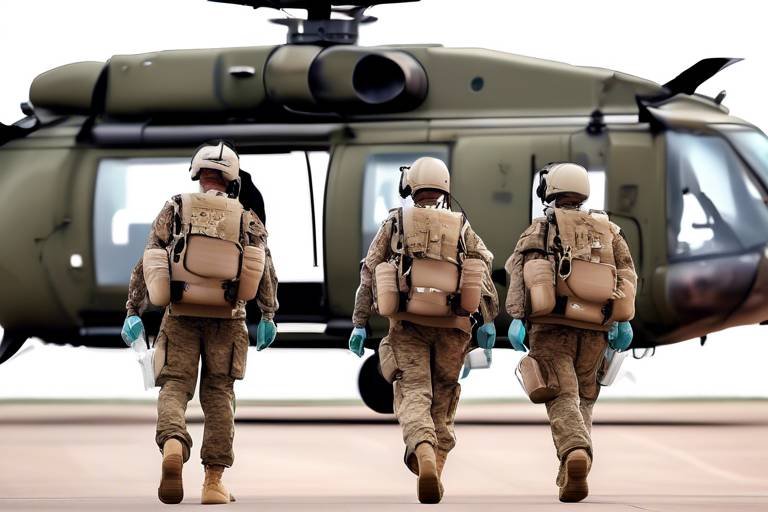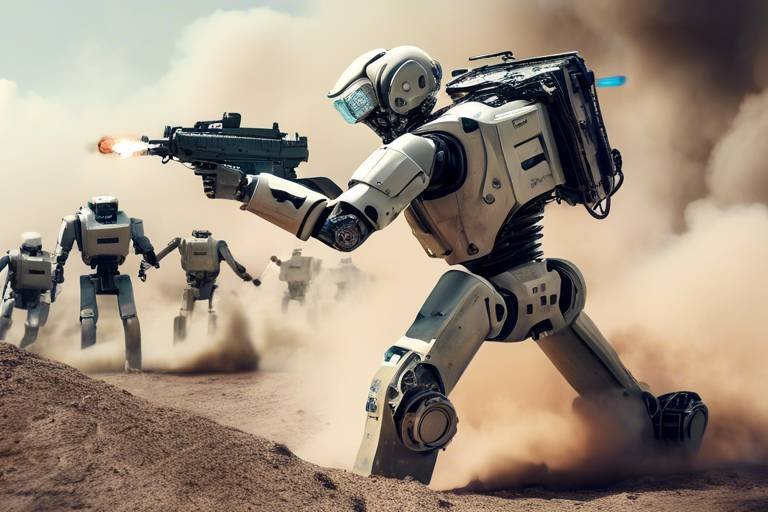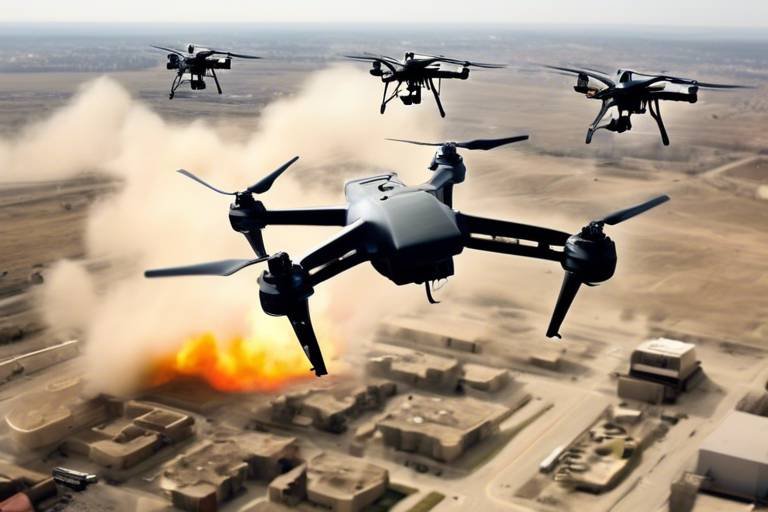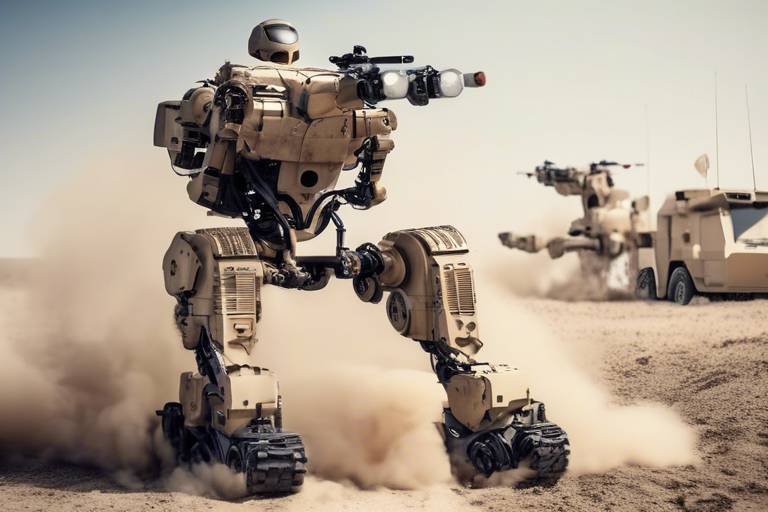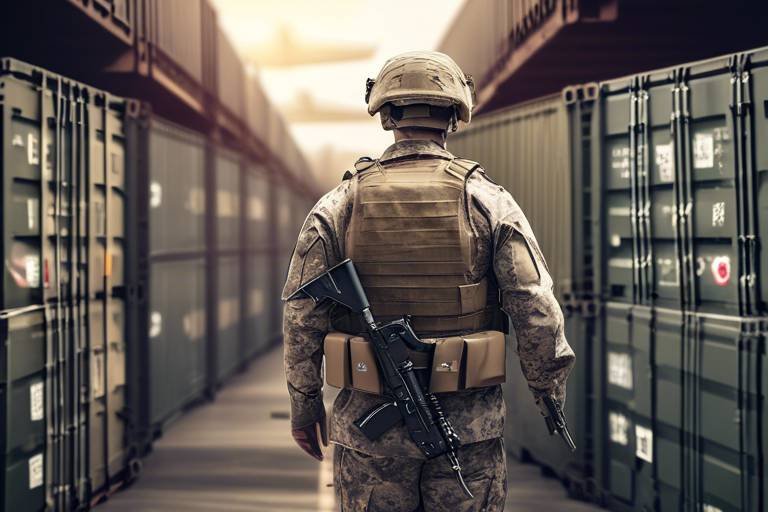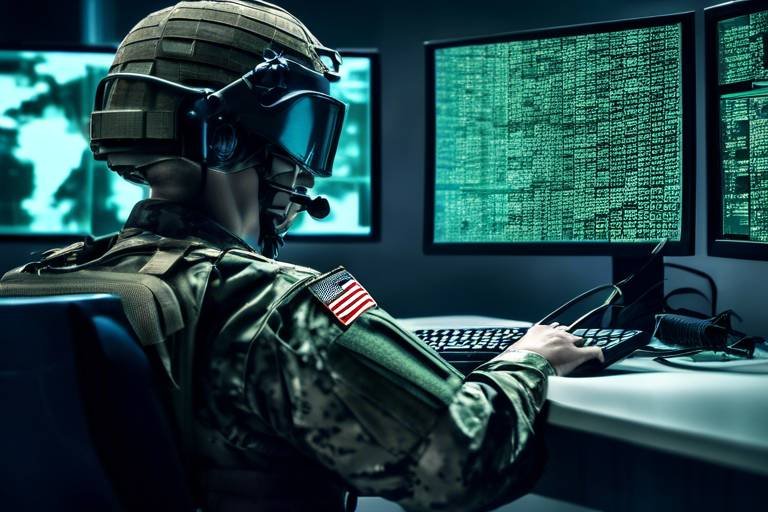How AI is Enhancing Military Medical Evacuation Protocols
The military landscape is evolving rapidly, and at the forefront of this transformation is artificial intelligence (AI). As we delve into the intricacies of military medical evacuation protocols, it becomes evident that AI is not just a buzzword; it is a game changer. Imagine a world where medical teams can respond to emergencies with lightning speed, where decisions are made based on real-time data, and where patient care is optimized like never before. This is not a distant future; it's happening now. AI is enhancing military medical evacuation processes by improving efficiency, decision-making, and patient care during critical situations.
In the heat of battle, every second counts. This is where AI-driven decision support systems come into play. These systems analyze vast amounts of real-time data, optimizing evacuation routes and resource allocation. Picture a scenario where a medical team receives an alert about a casualty. Instead of sifting through mountains of data, they have an AI system that instantly calculates the best route to the nearest medical facility, factoring in traffic, enemy positions, and available resources. It’s like having a personal assistant who knows exactly what to do in a crisis.
Another remarkable aspect of AI in military medicine is its use of predictive analytics. Imagine being able to assess a soldier's condition and forecast their potential outcomes before they even reach a medical facility. This capability allows military medical teams to prioritize care based on the urgency and severity of injuries. For instance, if a soldier has sustained multiple injuries, AI can help determine whether they need immediate surgical intervention or if they can wait for stabilization. This prioritization can be the difference between life and death.
Integrating real-time data from various sources enhances situational awareness for medical teams. This means that when evacuations occur, medical personnel are not operating in a vacuum. They have access to a wealth of information that enables them to make informed decisions quickly. Whether it’s tracking troop movements, assessing environmental hazards, or understanding the status of available medical resources, real-time data integration ensures that military medical teams are always one step ahead.
Imagine a soldier on the battlefield wearing a device that constantly monitors their health metrics. This is not science fiction; it’s the reality of wearable technology equipped with AI. These devices can alert medics to potential emergencies, facilitating faster response times during evacuations. For instance, if a soldier's heart rate spikes or their oxygen levels drop, the system can send an immediate alert, ensuring that medical teams can respond before the situation escalates.
Effective communication is crucial in any military operation, especially during medical evacuations. AI-powered communication tools streamline information sharing among military personnel. This ensures that medical teams receive accurate and timely updates regarding patient conditions and evacuation needs. Imagine a command center where every piece of information is instantly available, allowing for coordinated efforts that save lives.
During mass casualty situations, determining who needs care first can be overwhelming. This is where automated triage systems come in. Utilizing AI algorithms, these systems classify patients based on urgency, helping medical personnel prioritize care effectively. In a chaotic environment, having an automated system that can quickly assess and categorize injuries allows for a more organized and efficient response. It’s like having a supercharged triage nurse who never tires and always knows what to do.
Preparing military medical teams for real-world scenarios is essential, and AI-based training programs are stepping up to the challenge. Through advanced simulations, these programs enhance the skills of medical personnel in managing evacuations. Imagine a virtual reality training environment where medics can practice decision-making in high-pressure situations. This scenario-based learning not only builds confidence but also improves their ability to handle real-life emergencies effectively.
Scenario-based learning using AI allows medical personnel to face simulated emergencies that mimic real battlefield conditions. This immersive experience prepares them for the unexpected. By practicing in a controlled environment, they develop the skills necessary to make quick decisions, assess injuries, and coordinate evacuations, all while under pressure. It's like a pilot training in a flight simulator before taking off into the skies.
AI systems provide invaluable feedback on evacuation processes. This feedback loop allows military medical teams to analyze their performance and identify areas for improvement. By fostering a culture of continuous learning and adaptation, teams can refine their strategies and enhance their effectiveness in future operations. It’s a process of evolution where each experience builds on the last, ensuring that they are always improving.
- How does AI improve decision-making in military medical evacuations?
AI analyzes real-time data to provide optimal routes and resource allocation, enhancing timely responses. - What role do wearable technologies play in military medicine?
Wearable devices monitor soldiers' health metrics, alerting medics to emergencies and speeding up response times. - How are automated triage systems beneficial?
They classify patients based on urgency, helping prioritize care in mass casualty situations. - What is the significance of scenario-based learning?
It prepares medical personnel to handle real-life emergencies effectively through immersive simulations.

AI-Driven Decision Support Systems
Artificial intelligence is not just a buzzword; it's a game-changer in the realm of military medical evacuations. Imagine a scenario where every second counts, and the difference between life and death hinges on the ability to make quick, informed decisions. This is where come into play. By analyzing a plethora of real-time data, these systems optimize evacuation routes and resource allocation, ensuring that medical teams can respond swiftly and effectively in emergencies.
At the heart of these systems is the capability to process vast amounts of information almost instantaneously. Picture a busy command center during a crisis: data streams in from various sources, including battlefield reports, weather conditions, and patient statuses. An AI system can sift through this data, identifying the best evacuation paths while considering factors such as traffic, terrain, and potential hazards. This not only enhances the speed of decision-making but also significantly improves the safety of both the medical personnel and the patients being evacuated.
Moreover, the integration of machine learning algorithms allows these systems to learn from past evacuations. They can identify patterns that lead to successful outcomes and apply this knowledge to future scenarios. For example, if a particular route consistently results in delays due to enemy activity or natural obstacles, the AI can recommend alternative paths, ensuring that military medics are always one step ahead. In essence, these systems serve as a virtual co-pilot, guiding teams through the fog of war with precision and clarity.
One of the remarkable features of AI decision support systems is their ability to provide real-time recommendations based on evolving situations. When a medical team is en route to a casualty, the AI can continuously update them on the best course of action. This could involve rerouting to avoid ambushes or notifying them of additional casualties that require immediate attention. Such dynamic adaptability is crucial in high-stakes environments, where situations can change in the blink of an eye.
Additionally, the use of AI in decision support extends beyond just evacuation logistics. It encompasses the entire spectrum of patient care during evacuations. For instance, AI can analyze patient data to determine the most critical injuries and prioritize treatment accordingly. This ensures that the most severely injured soldiers receive the care they need as quickly as possible, potentially saving lives in the process.
In summary, are transforming military medical evacuations into a more efficient, responsive, and safer process. By harnessing the power of real-time data analysis and machine learning, these systems empower medical teams to make informed decisions rapidly, ultimately leading to better patient outcomes and enhanced operational effectiveness.
- What are AI-driven decision support systems?
AI-driven decision support systems use artificial intelligence to analyze real-time data and provide recommendations for optimal decision-making in military medical evacuations. - How do these systems improve evacuation efficiency?
They analyze various data streams to suggest the best evacuation routes and allocate resources effectively, ensuring timely responses during emergencies. - Can AI systems learn from past evacuations?
Yes, machine learning algorithms enable these systems to learn from historical data, helping improve future decision-making processes. - What role does real-time data play in these systems?
Real-time data integration enhances situational awareness, allowing medical teams to adapt their strategies based on the most current information available.

Predictive Analytics for Patient Outcomes
In the high-stakes world of military medical evacuations, the ability to anticipate patient needs can mean the difference between life and death. Predictive analytics powered by artificial intelligence is at the forefront of this transformation, allowing military medical teams to assess patient conditions and forecast outcomes with remarkable accuracy. Imagine having a crystal ball that not only tells you who needs immediate care but also predicts how they might respond to various treatments. This is what predictive analytics offers—a glimpse into the future of patient care during critical situations.
The integration of predictive analytics into military medical operations allows for a data-driven approach to prioritizing care. By analyzing historical data and real-time information, AI can identify patterns and trends that help medical personnel allocate resources more effectively. For instance, if a soldier presents with certain symptoms, the AI can compare these with previous cases to determine the likely severity of the injury and the urgency of care required. This means that medics can focus their efforts on the most critically injured first, ensuring that no time is wasted in delivering life-saving interventions.
One of the key components of predictive analytics is its ability to utilize machine learning algorithms that continuously improve as they process more data. This self-learning capability is crucial in a military context, where every second counts. For example, if a particular type of injury becomes prevalent in a specific combat zone, the system can adapt and provide tailored recommendations for treatment protocols, thereby enhancing the overall effectiveness of the evacuation process.
Additionally, the use of predictive analytics can streamline communication among various teams involved in the evacuation process. With real-time data integration, medical teams can share insights about patient conditions instantly. This collaboration ensures that everyone is on the same page and can respond swiftly to changing circumstances. The result is a more cohesive and efficient evacuation operation, where decisions are made based on the most current and comprehensive information available.
To illustrate the impact of predictive analytics, consider the following table that summarizes its benefits in military medical evacuations:
| Benefit | Description |
|---|---|
| Improved Prioritization | AI helps identify which patients require immediate attention based on predictive outcomes. |
| Resource Allocation | Efficient distribution of medical resources according to urgency and severity. |
| Enhanced Communication | Real-time data sharing leads to better coordination among medical teams. |
| Continuous Learning | Machine learning algorithms improve treatment protocols based on new data. |
In conclusion, the integration of predictive analytics into military medical evacuation protocols is a game changer. It not only enhances the ability of medical teams to respond effectively but also ensures that they are equipped with the insights needed to make critical decisions swiftly. As technology continues to evolve, the potential for further advancements in patient care during evacuations is limitless.
- How does predictive analytics improve patient outcomes in military evacuations?
Predictive analytics analyzes historical and real-time data to forecast patient conditions, enabling medical teams to prioritize care and allocate resources effectively. - What role does AI play in resource allocation during evacuations?
AI helps identify which patients need immediate attention, allowing for better resource distribution based on urgency and severity of injuries. - Can predictive analytics adapt to new types of injuries?
Yes, machine learning algorithms continuously improve by processing new data, allowing them to adapt to emerging patterns and treatment needs.

Real-Time Data Integration
In the fast-paced environment of military medical evacuations, plays a crucial role in enhancing the effectiveness of medical teams. Imagine being on a battlefield where every second counts; the ability to access and analyze data instantaneously can mean the difference between life and death. With the integration of various data sources, military medical personnel can gain a comprehensive understanding of the situation at hand, allowing them to make informed decisions swiftly.
One of the key benefits of real-time data integration is the ability to monitor multiple variables simultaneously. This includes patient vitals, environmental conditions, and the status of available medical resources. For instance, data from wearable health devices can be fed directly into a central system, providing medics with up-to-the-minute information about a soldier's condition. This allows for a more tailored response, as medics can prioritize care based on the most critical needs, ensuring that those who require immediate attention receive it without delay.
Moreover, the integration of data from various sources enhances situational awareness. By utilizing AI algorithms, military medical teams can visualize the battlefield and identify the safest and most efficient evacuation routes. Imagine a scenario where a medic is able to see not just the location of injured personnel but also the nearest medical facilities and the availability of transport options—all in real-time. This level of integration transforms the evacuation process into a well-coordinated operation rather than a chaotic scramble.
Additionally, real-time data integration allows for improved communication among team members. When everyone is on the same page, the chances of miscommunication are significantly reduced. AI-powered communication tools can facilitate the sharing of vital patient information and updates on evacuation needs, ensuring that every team member is aware of their roles and responsibilities. This seamless flow of information can be likened to a well-choreographed dance, where each participant knows exactly when to move and how to respond to the evolving situation.
To illustrate the benefits of real-time data integration, consider the following table that outlines its impact on military medical evacuations:
| Aspect | Traditional Method | Real-Time Data Integration |
|---|---|---|
| Decision Making | Delayed due to manual data collection | Instantaneous insights from multiple sources |
| Patient Monitoring | Periodic checks by medics | Continuous monitoring via wearable tech |
| Communication | Verbal updates, prone to errors | Automated updates, reducing miscommunication |
| Resource Allocation | Reactive, based on available data | Proactive, based on predictive analytics |
In conclusion, real-time data integration is not just a technological advancement; it is a game-changer in military medical evacuations. By leveraging the power of AI and data analytics, medical teams can operate with greater efficiency, ultimately leading to better patient outcomes. As we move forward, the continued evolution of these technologies promises to further enhance the capabilities of military medical personnel, ensuring they are always prepared to respond effectively in the most challenging environments.
- What is real-time data integration in military medical evacuations?
Real-time data integration refers to the process of combining and analyzing data from various sources instantaneously to enhance decision-making and situational awareness during medical evacuations. - How does AI contribute to real-time data integration?
AI algorithms can process vast amounts of data quickly, providing insights and visualizations that help medical teams make informed decisions in high-pressure situations. - What are the benefits of using wearable technology in military medicine?
Wearable technology enables continuous monitoring of soldiers' health metrics, allowing for quicker responses to medical emergencies and improved patient care during evacuations. - Can real-time data integration improve communication among medical teams?
Yes, by streamlining information sharing and providing automated updates, real-time data integration significantly reduces the chances of miscommunication among team members.

Wearable Technology in the Field
In the fast-paced environment of military operations, wearable technology has emerged as a game-changer, significantly enhancing the way medical teams respond to emergencies. Imagine a soldier in the field, equipped with a device that continuously monitors vital signs, detects anomalies, and alerts medics in real-time. This is not science fiction; it's the reality brought forth by advancements in wearable technology. These devices, which can range from smartwatches to specialized sensors, are designed to provide critical health data that can be pivotal during medical evacuations.
The integration of wearable technology into military operations allows for a seamless flow of information. For instance, these devices can track metrics such as heart rate, oxygen levels, and even stress indicators. When a soldier sustains an injury, the wearable can instantly send alerts to medical teams, specifying the nature of the injury and the soldier's current health status. This capability not only speeds up the response time but also ensures that medical personnel are adequately prepared before they even reach the casualty.
Furthermore, wearable devices can be programmed to communicate with AI-driven decision support systems. For example, if a soldier's health metrics indicate a critical condition, the system can analyze the data and recommend the most efficient evacuation route, taking into account factors like terrain and enemy activity. This synergy between wearable technology and AI creates a robust framework for decision-making that enhances the overall efficiency of medical evacuations.
Additionally, the data collected from wearable devices can be invaluable for post-mission analysis. By examining the health metrics of soldiers during missions, military medical teams can identify patterns and trends that inform future training and operational strategies. This continuous feedback loop fosters a culture of improvement and adaptation, ensuring that military personnel are always at the forefront of medical readiness.
In summary, the role of wearable technology in the field is not just about monitoring health; it's about transforming the entire landscape of military medical evacuations. By providing real-time data, enhancing communication, and integrating with advanced decision-making systems, these devices empower medical teams to act swiftly and effectively, ultimately saving lives in critical situations.
- What types of wearable technology are used in military medical evacuations?
Wearable technology can include smartwatches, health monitoring sensors, and specialized medical devices that track vital signs and other health metrics.
- How does wearable technology improve response times during evacuations?
These devices can alert medical teams instantly about a soldier's condition, allowing for quicker preparation and response, which is crucial in emergencies.
- Can wearable devices communicate with other systems?
Yes, many wearable devices are designed to integrate with AI-driven decision support systems, enhancing situational awareness and decision-making during medical evacuations.
- What data do wearable devices track?
Wearable devices can monitor various health metrics, including heart rate, oxygen saturation, temperature, and stress levels, providing a comprehensive view of a soldier's health.

Communication Enhancement Tools
In the high-stakes environment of military medical evacuations, effective communication can be the difference between life and death. That's where AI-powered communication enhancement tools come into play, revolutionizing the way military personnel share vital information. Imagine a scenario where a medic needs to relay a soldier's critical condition to a helicopter crew while navigating through enemy territory. In such moments, every second counts, and the precision of information shared can significantly impact the outcome.
These advanced tools utilize AI algorithms to streamline communication processes, ensuring that information flows seamlessly among all parties involved. For instance, real-time data analytics can help medics understand the urgency of a situation and communicate that urgency effectively to evacuation teams. This ensures that everyone involved is on the same page, reducing the risk of miscommunication that can lead to delays or errors in patient care.
Furthermore, the integration of AI in communication tools enhances the accuracy of patient data being shared. When a medic inputs a patient's status into a system, AI can automatically categorize and prioritize that information based on predefined protocols. This means that evacuation teams can receive alerts that are not just timely but also contextually relevant. For example, if a soldier is suffering from a severe traumatic injury, the system can flag this as a high-priority case, prompting a rapid response.
Additionally, these tools often come equipped with features such as voice recognition and natural language processing, allowing medics to communicate hands-free. This is particularly beneficial in chaotic environments where medics need to keep their hands free for immediate patient care. Imagine a medic being able to dictate a patient's condition while performing life-saving procedures—this technology makes that possible.
Moreover, the ability to integrate various communication channels—such as radios, smartphones, and satellite communications—into one cohesive platform further enhances operational efficiency. This multi-channel approach ensures that regardless of the equipment available, medics can maintain communication with evacuation teams, command centers, and other critical personnel. The result is a robust communication network that enhances situational awareness and facilitates quicker decision-making.
In summary, AI-powered communication enhancement tools are not just a luxury; they are a necessity in the realm of military medical evacuations. By ensuring that information is communicated swiftly, accurately, and efficiently, these tools play a crucial role in improving patient outcomes and enhancing the overall effectiveness of military medical operations.
- What are AI-powered communication enhancement tools?
These are advanced tools that utilize artificial intelligence to streamline and improve communication processes among military personnel during medical evacuations. - How do these tools improve decision-making?
By providing real-time data and analytics, these tools help medical teams make informed decisions quickly, ensuring timely responses to critical situations. - Can these tools be used in chaotic environments?
Yes, many AI communication tools are designed to function effectively in high-pressure situations, often featuring hands-free operation and multi-channel integration. - What role does natural language processing play?
Natural language processing allows medics to communicate verbally with the system, making it easier to relay patient information without needing to type or use hands.

Automated Triage Systems
Automated triage systems are a game-changer in the realm of military medical evacuations. Imagine being in a chaotic battlefield where every second counts; the ability to quickly assess and prioritize patient needs can literally mean the difference between life and death. These systems utilize advanced AI algorithms to classify patients based on the urgency of their conditions, which is crucial during mass casualty incidents. By streamlining the triage process, medical personnel can focus their efforts on those who need immediate attention, enhancing the overall effectiveness of medical response teams.
Think of automated triage systems as a sophisticated traffic management system, but instead of cars, we're dealing with patients. Just as traffic lights help direct vehicles to avoid congestion, these AI-driven tools help medical teams navigate the complexities of treatment priorities. By analyzing a multitude of factors—such as vital signs, injury severity, and even the patient's medical history—these systems can generate a clear picture of who requires urgent care. This process not only saves time but also optimizes the use of available medical resources.
One of the standout features of automated triage systems is their ability to adapt to real-time data. For instance, if a new patient arrives with severe injuries, the system can instantly re-evaluate the current situation and adjust the priorities accordingly. This dynamic capability is particularly vital in environments where conditions can change rapidly, such as during ongoing combat operations or natural disasters. The integration of AI into triage processes underscores a significant shift in how military medical teams approach emergency care.
| Feature | Description |
|---|---|
| Real-Time Assessment | Evaluates patient conditions as they arrive, adjusting priorities instantly. |
| Data Integration | Combines information from various sources for a comprehensive view of patient needs. |
| Resource Optimization | Ensures that medical resources are allocated based on urgency and necessity. |
Moreover, the implementation of these systems not only enhances patient care but also reduces the cognitive load on medical personnel. In high-pressure situations, where stress levels are elevated, having an AI system that can quickly categorize patients allows medics to concentrate on delivering care rather than getting bogged down in administrative tasks. This efficiency can lead to faster treatment times and better overall outcomes for injured soldiers.
In conclusion, automated triage systems are revolutionizing the way military medical teams operate during evacuations. By harnessing the power of AI, these systems provide a structured and efficient approach to managing patient care in chaotic environments. As technology continues to advance, we can expect even more sophisticated tools to emerge, further enhancing the capabilities of military medicine.
- What is an automated triage system?
An automated triage system uses AI algorithms to assess and prioritize patients based on the urgency of their medical conditions, especially in emergency situations. - How does AI improve triage processes?
AI enhances triage by quickly analyzing real-time data, allowing medical personnel to focus on the most critical cases and optimize resource allocation. - Can automated triage systems adapt to changing conditions?
Yes, these systems can re-evaluate patient priorities instantly based on new data, making them highly effective in dynamic environments.

Training and Simulation with AI
The integration of Artificial Intelligence in training and simulation for military medical teams is nothing short of revolutionary. Imagine a world where medics can practice their skills in a highly realistic environment, where every scenario is tailored to challenge their decision-making abilities. This is not just a dream; it's becoming a reality thanks to AI. These advanced systems allow for the creation of dynamic training programs that adapt in real-time, simulating the chaos and unpredictability of actual battlefield conditions.
One of the most significant advantages of AI-based training is the ability to conduct scenario-based learning. This approach immerses medical personnel in lifelike situations that require quick thinking and effective problem-solving. For instance, a medic might find themselves responding to a sudden ambush, with multiple casualties requiring immediate attention. The AI can create a variety of scenarios, each with different variables, ensuring that no two training sessions are alike. This not only keeps the training engaging but also prepares the medics for the unexpected.
Moreover, the feedback mechanism embedded in AI training systems plays a crucial role in enhancing the learning experience. After each simulation, participants receive detailed analytics on their performance, highlighting strengths and pinpointing areas for improvement. This feedback loop fosters a culture of continuous learning, where military medical teams are always evolving and refining their skills. Imagine receiving instant insights on your decision-making speed, accuracy in triage, and even communication effectiveness during high-pressure situations. This data-driven approach ensures that every training session contributes to the team's overall readiness.
In addition to real-time feedback, AI simulations can incorporate multidisciplinary training. This means that medical personnel can practice alongside other military units, such as logistics or combat teams, enhancing their collaborative skills. Understanding how to work seamlessly with other branches can significantly impact the efficiency of medical evacuations. For example, a medic might need to coordinate with a transport unit to ensure that the right resources are available at the right time. AI simulations can create these interconnected scenarios, allowing teams to practice and refine their communication and operational strategies.
Furthermore, the scalability of AI training programs cannot be overlooked. These systems can be deployed across various military bases, ensuring that all personnel, regardless of location, have access to the same high-quality training. This uniformity is crucial in maintaining a standard of care and operational efficiency across the board. With AI, the military can ensure that every medic, whether stationed in a remote outpost or a bustling base, is equally prepared for the challenges they may face.
In conclusion, AI is not just enhancing military medical training; it is transforming it. By creating realistic, adaptable, and data-driven training environments, AI equips medical personnel with the skills they need to excel in high-stress situations. The future of military medical evacuations looks bright, and with AI at the helm, we can expect a generation of medics who are not only well-trained but also ready to face any challenge head-on.
- How does AI improve military medical training?
AI enhances training by providing realistic simulations that adapt to various scenarios, allowing medics to practice decision-making in high-pressure environments. - What is scenario-based learning?
Scenario-based learning involves immersing medical personnel in lifelike situations that require quick thinking and effective problem-solving. - How does feedback work in AI training systems?
After each simulation, participants receive detailed analytics on their performance, helping them identify strengths and areas for improvement. - Can AI training be standardized across different locations?
Yes, AI training programs can be deployed across various military bases, ensuring uniform training quality for all personnel.

Scenario-Based Learning
Scenario-based learning is a game changer in the realm of military medical evacuations, especially when we consider the unpredictable nature of combat zones. Imagine a soldier on the battlefield, injured and in need of immediate medical attention. In such high-pressure situations, the ability to make quick, informed decisions can mean the difference between life and death. This is where AI-driven simulations come into play, providing invaluable training to medical teams.
Through realistic, immersive scenarios, military medical personnel can practice their skills in a controlled environment without the real-world consequences. These simulations allow them to face various challenges, such as mass casualty incidents, environmental hazards, and equipment failures. For example, a simulation might present a scenario where multiple soldiers are injured simultaneously, requiring the team to prioritize care based on the severity of injuries. This kind of training not only enhances their clinical skills but also boosts their confidence in handling real-life emergencies.
Furthermore, the integration of AI technology into these training programs allows for a more tailored learning experience. Each simulation can adapt in real-time based on the decisions made by the participants. If a medical team struggles with a particular aspect of evacuation protocol, the AI can adjust the scenario to focus on that weakness, providing targeted practice. This level of customization ensures that each team member is well-prepared for any situation they might encounter.
Additionally, scenario-based learning fosters teamwork and communication among medical personnel. In a real evacuation, every second counts, and effective collaboration can significantly enhance patient outcomes. By engaging in these simulations, teams learn to communicate more effectively, ensuring that everyone is on the same page when it comes to patient care and evacuation strategies. They practice conveying critical information quickly and accurately, which is essential in chaotic environments.
To illustrate the impact of scenario-based learning, consider the following table that outlines the benefits of this training method:
| Benefit | Description |
|---|---|
| Enhanced Decision-Making | Participants learn to make quick decisions under pressure, simulating real-life scenarios. |
| Improved Teamwork | Encourages collaboration and communication among medical personnel during evacuations. |
| Customized Learning | AI adapts scenarios based on individual and team performance, addressing specific weaknesses. |
| Increased Confidence | Repeated practice in a safe environment builds confidence in handling real emergencies. |
In conclusion, scenario-based learning powered by AI is revolutionizing the training of military medical teams. By simulating high-pressure situations, these programs not only enhance clinical skills but also prepare personnel for the unpredictable challenges they may face in the field. As technology continues to evolve, the integration of AI in training will undoubtedly lead to even more effective and efficient military medical evacuations.
- What is scenario-based learning? Scenario-based learning is a training method that uses realistic simulations to help individuals practice skills in high-pressure situations.
- How does AI enhance scenario-based learning? AI can adapt scenarios in real-time based on participant decisions, providing targeted training and feedback.
- Why is teamwork important in military medical evacuations? Effective teamwork ensures that medical personnel can communicate quickly and accurately, which is crucial for patient care in emergencies.
- Can scenario-based learning improve decision-making skills? Yes, by simulating real-life challenges, participants can practice making quick and informed decisions, enhancing their overall effectiveness.

Feedback and Continuous Improvement
This article explores the transformative role of artificial intelligence in improving military medical evacuation processes, focusing on efficiency, decision-making, and patient care during critical situations.
AI systems are revolutionizing decision-making in military medical evacuations by analyzing real-time data to optimize evacuation routes and resource allocation, ensuring timely and effective responses in emergencies.
Predictive analytics powered by AI can assess patient conditions and forecast outcomes, allowing military medical teams to prioritize care and allocate resources based on urgency and severity of injuries.
Integrating real-time data from various sources enhances situational awareness for medical teams, enabling them to make informed decisions quickly during evacuations and improve overall operational efficiency.
Wearable devices equipped with AI can monitor soldiers' health metrics in real time, alerting medics to potential emergencies and facilitating faster response times during evacuations.
AI-powered communication tools streamline information sharing among military personnel, ensuring that medical teams receive accurate and timely updates regarding patient conditions and evacuation needs.
Automated triage systems utilize AI algorithms to classify patients based on urgency, helping medical personnel prioritize care during mass casualty situations and ensuring that the most critical cases are addressed first.
AI-based training programs and simulations prepare military medical teams for real-world scenarios, enhancing their skills in managing evacuations and improving their response to various medical emergencies.
Scenario-based learning using AI allows medical personnel to practice decision-making in high-pressure situations, improving their ability to handle real-life emergencies effectively during evacuations.
In the fast-paced world of military medical evacuations, feedback and continuous improvement are not just beneficial; they are essential. AI systems play a crucial role in gathering and analyzing data from each evacuation mission. This data can include everything from response times to patient outcomes, providing invaluable insights into what worked and what didn’t.
By utilizing advanced analytics, military medical teams can identify patterns and trends that may not be immediately apparent. For instance, if a particular evacuation route consistently results in delays, the team can investigate further to understand the underlying issues. This process of reflection and analysis ensures that lessons learned are not just noted but actively integrated into future operations.
Moreover, AI systems can facilitate a culture of continuous learning. They can be programmed to provide real-time feedback during training simulations, highlighting areas where a medical team might improve their response or decision-making skills. This immediate feedback loop is akin to having a personal coach who guides you through each step, helping you refine your techniques and strategies.
To illustrate the impact of feedback on performance, consider the following table that summarizes key performance indicators tracked by AI systems:
| Performance Indicator | Description | Impact of AI Feedback |
|---|---|---|
| Response Time | Time taken from alert to arrival on scene | Identifying delays allows for route optimization |
| Patient Stabilization Rate | Percentage of patients stabilized before evacuation | Improves triage protocols based on past successes |
| Resource Utilization | Efficiency of medical supplies and personnel used | Informs better allocation in future missions |
Ultimately, the integration of AI in feedback mechanisms fosters a proactive approach to improvement. Medical teams are not merely reacting to incidents; they are anticipating challenges and preparing solutions. This shift in mindset can significantly enhance the effectiveness of military medical evacuations, ensuring that every soldier receives the best possible care in their time of need.
- How does AI improve decision-making in medical evacuations?
AI analyzes real-time data to optimize routes and resource allocation, allowing for quicker and more effective responses. - What role does predictive analytics play in military medicine?
It helps assess patient conditions and predict outcomes, enabling prioritization of care based on urgency. - How does feedback contribute to continuous improvement?
AI systems provide insights on performance, allowing teams to identify areas for improvement and adapt their strategies accordingly.
Frequently Asked Questions
- How does AI improve military medical evacuation protocols?
AI enhances military medical evacuation by optimizing decision-making, improving real-time data integration, and streamlining communication. This ensures that medical teams can respond effectively to emergencies, prioritize patient care, and allocate resources efficiently.
- What role do predictive analytics play in patient outcomes?
Predictive analytics utilize AI to assess patient conditions and forecast potential outcomes. This allows military medical teams to prioritize care based on the urgency and severity of injuries, leading to better management of resources during evacuations.
- How does real-time data integration benefit medical teams?
Integrating real-time data enhances situational awareness, enabling medical teams to make informed decisions quickly. This capability improves operational efficiency during evacuations, ensuring that the right care is delivered at the right time.
- What are the advantages of wearable technology in the field?
Wearable technology equipped with AI monitors soldiers' health metrics in real time, alerting medics to potential emergencies. This facilitates faster response times and enhances overall patient care during evacuations.
- How do automated triage systems function?
Automated triage systems use AI algorithms to classify patients based on the urgency of their conditions. This helps medical personnel prioritize care during mass casualty situations, ensuring that the most critical cases are addressed first.
- What types of training do AI-based programs provide?
AI-based training programs offer scenario-based learning that prepares military medical teams for real-world situations. This enhances their skills in managing evacuations and improves their response to various medical emergencies.
- How does AI contribute to feedback and continuous improvement?
AI systems provide valuable feedback on evacuation processes, allowing military medical teams to analyze performance and identify areas for improvement. This fosters a culture of continuous learning and adaptation within the teams.

